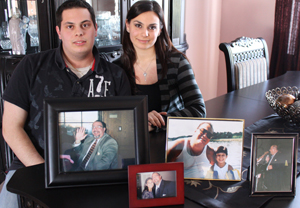
Eddie and Marisa Allegretto, of Colonia, are among the children of 9/11 victims who told their stories. Their father, Edward Allegretto, Sr., was killed in the attack. Photo: David Seamon
Hundreds of New Jersey’s fathers and mothers went to work at the World Trade Center on September 11, and never made it home.
Some of their school-age children waited all day in auditoriums to be picked up, but no one came. Other grown children learned the news by text message or cell phone. And some were not even born when two planes slammed into the towers, reducing Lower Manhattan to fire, rubble, and lung-choking dust.
Now, 20 of these children and one parent of a child who died tell their stories about the decade that followed 9/11 in a new iBook compiled by Ronald Miskoff and Liz Fuerst of the Rutgers University Department of Journalism and Media Studies. The project, called 9/11 Stories:The Children, has been released on iTunes as the May 21 opening of the National September 11 Memorial Museum approaches.The 156-page book focuses on the families – not the politics or historical implications of the attacks. It is presented in a multimedia format with text, video and photographs.“It is almost impossible to understand the stress suffered by the children of people who died in the attacks,” said Miskoff. “This book allows readers to understand what happened to the children, many now grown, 10 years after 9/11.”
The project grew out of a narrative journalism course Miskoff and Fuerst taught prior to the 10th anniversary of the Twin Towers collapse. It contains the original interviews and photos as well as edited versions of the videos their students shot on location. Rutgers students conducted interviews with the children of the victims of the attacks in mid-2011. The book, which includes essays, before-and-after photos of the children and videos, gives readers a detailed look at what followed the tragedy of 9/11 in personal terms.
“Up until now, most of the tales about 9/11 children were grab-and-run journalism stories by older reporters who were working on deadline,” noted Miskoff. “This project allowed the students to spend time with each child of 9/11 to gain a full [sic] understanding of the difficult time each child faced after 9/11.”
“Now that they are older, the children can express themselves in ways that were impossible when they were pre-teens,” said Fuerst.
Fuerst cited the story of the young woman whose father loved to watch her dance, who then pursued a career in dance and laments that her father cannot watch her now. Another child, whose father wanted him to be an outstanding sportsman, decided to pursue a career in music, something closer to his heart.
“These are not cardboard tales dreamed up by a press agent to mollify readers’ morbid curiosity; they are real, breathing stories that allow readers to understand of the effects of 9/11 on the victims’ families,” said Fuerst.
There is some commonality in these stories. One subject after another describes the horror of coming home from school to find a house full of family and neighbors — along with strangers they never saw. Many of them shared the experience of spending time in a summer camp for children of 9/11 victims.
In every case, the children did not hold back anything; they expressed their resentment of insensitive adults and classmates as well as their appreciation for uncles who stepped in to act as surrogate fathers or mothers who dealt with the horrors of the disaster but kept the family together.
“There are no punches pulled here,” stated Miskoff. “Readers will find some of the videos uplifting but others sad and difficult to watch without crying.”
The book is available on iTunes and iBooks for $1.99. The project will soon be in ebook format. It was supported by a grant from the New Jersey Press Foundation and the foundation created by the North Jersey Media Group.
To purchase the book, go to iTunes, click on “Books” and place the title of the book (9/11 Stories: The Children) in the index. You may be directed to download the app “iBooks” and then search for the title.

